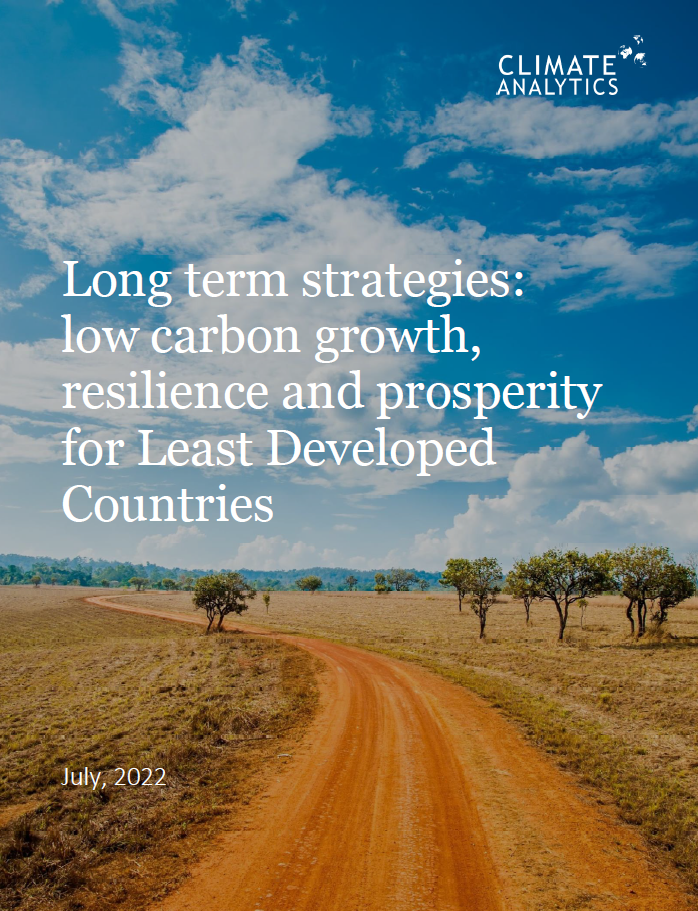Resilience Building In Least Developed Countries: Strategies For Sustainable Transformation

Table of Contents
Strengthening Institutional Capacity for Disaster Risk Reduction and Management
Effective governance and robust disaster management systems are cornerstones of resilience building. This involves strengthening institutional capacity at all levels, from national governments to local communities.
Improved Governance and Transparency
Establishing effective, accountable, and transparent governance structures is paramount. This requires:
- Strengthening anti-corruption measures: Transparency International's Corruption Perception Index highlights the correlation between corruption and vulnerability to disasters. Reducing corruption ensures that aid and resources reach those who need them most.
- Promoting participatory decision-making involving local communities: Local knowledge is crucial for effective disaster risk reduction. Involving communities in planning and implementation fosters ownership and ensures that solutions are context-specific and culturally appropriate.
- Investing in capacity building for government officials: Training programs focused on disaster risk reduction and management, good governance, and financial management are essential for building institutional capacity. This includes training on using new technologies for early warning systems and data analysis.
Early Warning Systems and Disaster Preparedness
Advanced early warning systems are vital for minimizing the impact of disasters. This necessitates:
- Implementing advanced early warning systems for various hazards (droughts, floods, etc.): Investing in technology like weather satellites, hydrological monitoring, and seismic sensors provides crucial lead time for evacuation and preparedness measures.
- Developing comprehensive disaster preparedness plans: These plans should detail evacuation routes, emergency shelters, resource allocation, and communication protocols. Regular updates and drills are essential.
- Conducting regular disaster drills and simulations: These exercises test the effectiveness of preparedness plans and identify areas for improvement. They also familiarize communities with emergency procedures.
- Investing in robust communication infrastructure: Reliable communication is essential for disseminating warnings and coordinating rescue efforts. This includes investing in mobile networks, radio systems, and community-based communication strategies.
Community-Based Disaster Risk Reduction
Empowering local communities is crucial for building bottom-up resilience. This means:
- Promoting community-based early warning systems: Local knowledge can supplement technological early warning systems. Communities can identify local indicators of impending disasters and develop their own warning mechanisms.
- Supporting the development of local coping mechanisms: This could include diversifying livelihoods, developing water storage solutions, or implementing agroforestry techniques.
- Training community members in disaster response techniques: Training in first aid, search and rescue, and damage assessment empowers communities to respond effectively to disasters.
Investing in Climate-Resilient Infrastructure and Agriculture
Climate change exacerbates existing vulnerabilities. Investing in resilient infrastructure and climate-smart agriculture is essential for long-term resilience.
Climate-Smart Agriculture
Promoting agricultural practices that can withstand extreme weather events is crucial for food security. This includes:
- Drought-resistant crop varieties: Investing in research and development of drought-resistant crops reduces reliance on unpredictable rainfall.
- Water harvesting and conservation techniques: Techniques like rainwater harvesting, drip irrigation, and efficient water management practices reduce vulnerability to drought.
- Sustainable land management practices: Practices like terracing, agroforestry, and crop rotation protect soil health and improve water retention.
Resilient Infrastructure Development
Building infrastructure that can withstand climate change impacts is essential. This involves:
- Flood-resistant housing and roads: Constructing buildings and infrastructure using appropriate materials and designs reduces damage from floods.
- Drought-resistant water systems: Investing in reliable water storage and distribution systems ensures access to water even during droughts.
- Climate-resilient energy infrastructure: Investing in renewable energy sources reduces reliance on vulnerable energy systems and mitigates climate change.
Sustainable Resource Management
Protecting ecosystems is fundamental to building resilience. This requires:
- Combating deforestation: Deforestation increases vulnerability to floods and landslides. Sustainable forest management practices are vital.
- Promoting sustainable forestry practices: Responsible logging and reforestation efforts help maintain ecosystem services.
- Protecting biodiversity: Biodiversity enhances ecosystem resilience and provides vital resources.
Diversifying Economies and Promoting Inclusive Growth
Economic diversification reduces reliance on vulnerable sectors and promotes resilience to shocks.
Economic Diversification
Reducing reliance on vulnerable sectors requires:
- Promoting value-added industries: Processing agricultural products locally increases income and reduces reliance on export markets.
- Supporting small and medium-sized enterprises (SMEs): SMEs are engines of economic growth and job creation. Supporting them through access to finance and training strengthens resilience.
- Developing tourism and other service sectors: Developing these sectors creates jobs and diversifies income sources.
Investment in Human Capital
Investing in people builds a more resilient workforce. This involves:
- Improving access to quality education: Education empowers individuals and provides them with the skills they need to adapt to changing circumstances.
- Improving access to healthcare services: Good health is essential for productivity and resilience to shocks.
- Providing vocational training and skills development programs: This equips individuals with the skills they need to participate in a diversified economy.
Social Safety Nets
Robust social safety nets protect vulnerable populations from shocks. This includes:
- Cash transfer programs: These provide vulnerable households with financial support during emergencies.
- Food security programs: These ensure access to food during times of crisis.
- Unemployment insurance: This provides income support to those who lose their jobs.
Fostering Regional and International Cooperation
International cooperation is crucial for building resilience in LDCs.
Knowledge Sharing and Technology Transfer
Sharing best practices and technologies accelerates progress. This requires international collaboration and knowledge exchange platforms.
Financial and Technical Assistance
Increased financial and technical assistance from developed countries and international organizations is vital for supporting resilience-building initiatives.
Collaborative Disaster Response
Improving coordination and collaboration among countries in disaster response and recovery enhances effectiveness.
Conclusion
Building resilience in Least Developed Countries requires a holistic approach encompassing institutional strengthening, infrastructure development, economic diversification, and robust international cooperation. By implementing the strategies outlined above, these nations can better withstand shocks and build a pathway towards sustainable and inclusive development. Investing in resilience building is not just a humanitarian imperative, but a crucial step towards achieving the Sustainable Development Goals. Let's commit to strengthening resilience building in Least Developed Countries and work together to create a more secure and prosperous future for all.

Featured Posts
-
 Macrons Plan For A European Streaming Giant Progress And Challenges
May 07, 2025
Macrons Plan For A European Streaming Giant Progress And Challenges
May 07, 2025 -
 Analyzing The Celebrity Edition Of Who Wants To Be A Millionaire
May 07, 2025
Analyzing The Celebrity Edition Of Who Wants To Be A Millionaire
May 07, 2025 -
 Warszawa Wybory Papieskie Ksiazka Ks Przemyslawa Sliwinskiego Ujawnia Tajemnice Konklawe
May 07, 2025
Warszawa Wybory Papieskie Ksiazka Ks Przemyslawa Sliwinskiego Ujawnia Tajemnice Konklawe
May 07, 2025 -
 Svetovy Pohar Hokeja Sa Vracia V Roku 2028 Potvrdenie Nhl
May 07, 2025
Svetovy Pohar Hokeja Sa Vracia V Roku 2028 Potvrdenie Nhl
May 07, 2025 -
 Netflixs Cobra Kai A Deep Dive Into Its Karate Kid Legacy
May 07, 2025
Netflixs Cobra Kai A Deep Dive Into Its Karate Kid Legacy
May 07, 2025
